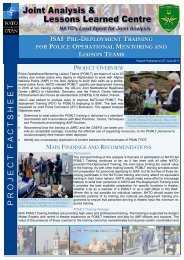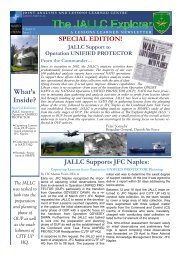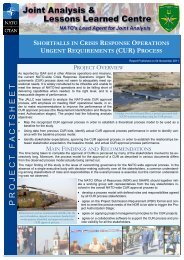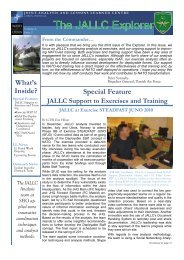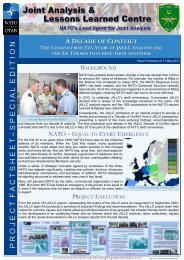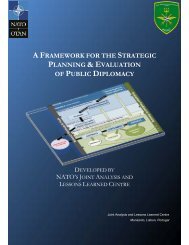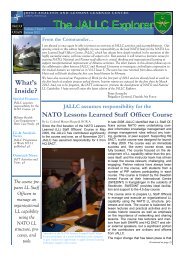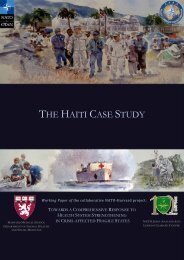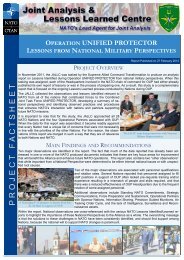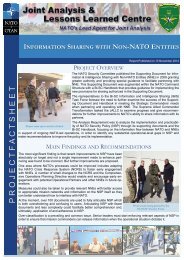5.2 Estimate of permanent funds <strong>in</strong> the Defence budgetrelated to <strong>ISAF</strong>In addition to the fact that this <strong>evaluation</strong> discusses the various aspects ofthe Review Protocol, it also serves as a policy assessment for the Defenceorganisation. To this end, the funds employed for the specific policy area <strong>in</strong>question must be described. In addition to the expenditure <strong>in</strong> the context ofthe mission, an <strong>in</strong>dication can also be given of the permanent funds which,while form<strong>in</strong>g part of the regular Defence budget, can be related to the<strong>ISAF</strong> <strong>participation</strong>. In the context of this policy assessment, a modelbased33 estimate was made of the funds bear<strong>in</strong>g relation to the deploymentof the armed forces to <strong>ISAF</strong> <strong>in</strong> the years covered <strong>in</strong> this <strong>evaluation</strong>. Thisestimate amounted to EUR 130 million per year for the duration of themission. The funds form part of the organisational and programme-relatedexpenditure of the Defence organisation which are used for the susta<strong>in</strong>mentand read<strong>in</strong>ess of the armed forces dur<strong>in</strong>g peacetime operations. If a missionis be<strong>in</strong>g conducted, a portion of these funds can be ascribed to thatmission. The same applies to the <strong>ISAF</strong> mission dur<strong>in</strong>g the <strong>2006</strong>-<strong>2010</strong>period. This concerns parts of the operational budgets of the fourOperational Commands, Support Command and the Defence MaterielOrganisation. These were used for, for <strong>in</strong>stance, exercises <strong>in</strong> the work-upphase prior to deployment to Afghanistan, or for Support Commandpersonnel stationed <strong>in</strong> the <strong>Netherlands</strong> who were <strong>in</strong>volved with thetransport to and from the mission area. These budgets would also havebeen used <strong>in</strong> peacetime operations, but <strong>in</strong> that case they would havecovered regular exercise and tra<strong>in</strong><strong>in</strong>g activities. These budgets cantherefore not be accounted to the total expenditure of the mission.5.3 Implementation aspects5.3.1 Personnel aspects of the mission5.3.1.1 Personnel organisationThe overall size of the <strong>Netherlands</strong>’ contribution to <strong>ISAF</strong> fluctuated.Whereas the estimated number of personnel stated <strong>in</strong> the 2005 decision toparticipate was 1,200 (950 of which to be stationed <strong>in</strong> Uruzgan), the actualnumber reached a maximum of 2,000 military personnel <strong>in</strong> 2009, despitethe fact that the 2007 decision to extend the mission provided for areduction of the number by transferr<strong>in</strong>g tasks from the <strong>Netherlands</strong> to otherparties (France, Hungary, Slovakia and the Czech Republic). The causes ofthis quantitative rise are found <strong>in</strong> developments <strong>in</strong> the security situation,the grow<strong>in</strong>g importance of tra<strong>in</strong><strong>in</strong>g the Afghan army and police, and thenational <strong>in</strong>put of additional assets (e.g. the RecceLight reconnaissancesystem for the F-16). The extension of the <strong>in</strong>k blot also led to a need formore military personnel. When the mission was concluded, the build-up ofthe Afghan army and police had not yet reached the stage where they wereready to take over responsibility for the security of the population centresfrom TFU. Dutch military personnel cont<strong>in</strong>ued to be necessary along withAfghans to guarantee security <strong>in</strong> those areas. At the same time, however,Dutch personnel were needed to achieve expansion of the <strong>in</strong>k blots. This iswhy there was no further expansion of the <strong>in</strong>k blots.The personnel numbers stated <strong>in</strong> the Article 100 letters were perceived aslead<strong>in</strong>g for the composition of the TFU. The personnel on location perceived33 The calculation model designed as part of the Future Policy Survey project was used for this estimate. In thismodel, all of the Defence budget (with the exception of HGIS) is ascribed to the specific operational units of thearmed forces. For this particular calculation, the representative units that bear relation to the contribution to <strong>ISAF</strong><strong>2006</strong>-<strong>2010</strong> were generated from the model.Page 88 of 133
this situation as constra<strong>in</strong><strong>in</strong>g, for it made it impossible for all additionalrequirements to be met. The commanders on location therefore had to setpriorities dur<strong>in</strong>g deployment.Compared to earlier missions, the deployment of the TFU <strong>in</strong>volved arelatively large number of civilian personnel, although it may seem limitedwhen set aga<strong>in</strong>st the number of military personnel. The number of civilianrepresentatives of the M<strong>in</strong>istry of Foreign Affairs grew substantially dur<strong>in</strong>gthe course of the mission. At the outset of the mission, there were threeofficials from Foreign Affairs: one political adviser (POLAD), onedevelopment cooperation adviser (OSAD) and one cultural adviser (CULAD).The civilian team from Foreign Affairs was expanded with a CivilRepresentative (CIVREP) <strong>in</strong> the summer of 2007, and several extra POLADsand OSADs were added later. By the end of the mission, their number hadquadrupled to 12 civilian personnel per rotation. In addition to thediplomats from the M<strong>in</strong>istry of Foreign Affairs, the civilian personnelcomprised functional specialists (reserve officers), militarised <strong>in</strong>terpretersand other militarised civilian personnel.Between <strong>2006</strong> and <strong>2010</strong>, a total of 130 civil servants of the M<strong>in</strong>istry ofForeign Affairs were directly <strong>in</strong>volved <strong>in</strong> the <strong>Netherlands</strong>’ mission <strong>in</strong>Uruzgan. A total of over 60 civilian personnel participated <strong>in</strong> six-monthlyrotations <strong>in</strong> the Uruzgan PRT as POLADs, CULADs, OSADs or <strong>in</strong>terpreters.Dur<strong>in</strong>g the mission, the composition and the number of officials constitut<strong>in</strong>gthe PRT changed several times. The staff<strong>in</strong>g of the political and socioeconomicdepartment of the embassy <strong>in</strong> Kabul was also doubled because ofthe mission. Dur<strong>in</strong>g the second half of the deployment (2008-<strong>2010</strong>), acounternarcotics adviser from the M<strong>in</strong>istry of the Interior and K<strong>in</strong>gdomRelations jo<strong>in</strong>ed the civilian team of the mission. From <strong>2006</strong>, a politicaladviser was posted to the <strong>ISAF</strong> regional headquarters at Kandahar Airfieldevery six months, as a strategic detachment and also <strong>in</strong> the context of theperiods <strong>in</strong> which the <strong>Netherlands</strong> held command of RC-S.Besides the deployment <strong>in</strong> TFU and ATF, Dutch personnel were alsodeployed to the <strong>ISAF</strong> Headquarters, the IJC <strong>in</strong> Kabul, and the RC-S atKandahar Airfield. Dutch flag and general officers filled a number of<strong>in</strong>fluential positions. The Dutch deployment for <strong>ISAF</strong> was supported bylogistic detachments stationed at Kandahar Airfield and <strong>in</strong> the UAE.5.3.1.2 Work-up phaseDutch service personnel are generically and organically (mean<strong>in</strong>g <strong>in</strong> unitswith fixed compositions and under the command of their own staffs) tra<strong>in</strong>edto the “Operationally Ready” level. For the mission <strong>in</strong> Uruzgan, the TaskForce was chosen as the form of deployment. For its specific task <strong>in</strong>Uruzgan, this Task Force was formed as a composite unit, built up fromorganic entities and additional elements (for <strong>in</strong>stance, a comb<strong>in</strong>ation ofarmoured and airmobile <strong>in</strong>fantry and mar<strong>in</strong>es). This ad hoc compositionmeant that str<strong>in</strong>gent requirements were imposed on the preparations <strong>in</strong> thework-up phase <strong>in</strong> order to achieve the “Operationally Ready” level. Tra<strong>in</strong><strong>in</strong>gpersonnel to perform non-organic tasks and to work with non-organicmateriel, the limited availability of the equipment to be used <strong>in</strong> Uruzgan(e.g. Bushmasters and night-vision equipment), and <strong>in</strong>tegration of thecomposite unit comb<strong>in</strong>ed to form a great challenge.In the beg<strong>in</strong>n<strong>in</strong>g of the mission, the work-up paths of civilian and militarypersonnel were largely separate. But before long it was acknowledged thata collective work-up would be beneficial to performance <strong>in</strong> the field. As themission progressed, efforts were made to improve the coord<strong>in</strong>ation of bothPage 89 of 133
- Page 1 and 2:
Final evaluationNetherlands contrib
- Page 3 and 4:
High mountainsLow mountainsPlains a
- Page 5 and 6:
Table of ContentsDutch military per
- Page 7 and 8:
Dutch military personnel deceased i
- Page 9 and 10:
Page 9 of 133
- Page 11 and 12:
1 IntroductionThe government would,
- Page 13 and 14:
The structure of the final evaluati
- Page 15 and 16:
2 The international presence in Afg
- Page 17 and 18:
insurgents in, particularly, the ea
- Page 19 and 20:
3 Netherlands policy for participat
- Page 21 and 22:
Netherlands’ presence. Furthermor
- Page 23 and 24:
“The objectives of this stabilisa
- Page 25 and 26:
In December 2005, the Netherlands g
- Page 27 and 28:
The expectation is that meaningful
- Page 29 and 30:
3.6.2 Implementation of national pr
- Page 31 and 32:
4 Implementation of the mission and
- Page 33 and 34:
tasks to fulfil in the area of secu
- Page 35 and 36:
such as the Bushmaster, that was be
- Page 37 and 38: Afghan partner unit, at all times o
- Page 39 and 40: northern part of Deh Rawod in 2007.
- Page 41 and 42: in large and small bases, while con
- Page 43 and 44: previously thought and comprised a
- Page 45 and 46: Apart from facilitating training an
- Page 47 and 48: If operations in close proximity of
- Page 49 and 50: As previously mentioned, the preven
- Page 51 and 52: - Between 2006 and 2010, the number
- Page 53 and 54: government of Chora in January 2010
- Page 55 and 56: At the beginning of the Dutch missi
- Page 57 and 58: intermediary of TLO and political a
- Page 59 and 60: interest for filling judicial posit
- Page 61 and 62: During the Uruzgan mission, a great
- Page 63 and 64: structurally change governance in U
- Page 65 and 66: development programmes. Before the
- Page 67 and 68: also the way in which Afghans perce
- Page 69 and 70: tailored to the real needs of the p
- Page 71 and 72: Gizab had increased and there was a
- Page 73 and 74: The DCU programme devoted and still
- Page 75 and 76: purpose of these loans, cooperative
- Page 77 and 78: In view of the lack of enthusiasm a
- Page 79 and 80: 5 Expenditure for the mission and i
- Page 81 and 82: Overview of long-term expenditure a
- Page 83 and 84: expenditure related to the deployme
- Page 85 and 86: Multi-year expenditure, Foreign Aff
- Page 87: explosive ordnance disposal, armour
- Page 91 and 92: organised at a later stage. In addi
- Page 93 and 94: occupational social workers and the
- Page 95 and 96: Mercedes Benz terrain vehicle, the
- Page 97 and 98: 6 ConclusionsThis chapter begins wi
- Page 99 and 100: The first part of the central quest
- Page 101 and 102: At the end of 2005, the Afghan auth
- Page 103 and 104: province. This, too, was done by me
- Page 105 and 106: area, increased sales of agricultur
- Page 107 and 108: ISAF and the OEF led to extra coord
- Page 109 and 110: d. The recommendations from advisor
- Page 111 and 112: Page 111 of 133
- Page 113 and 114: Annex A, Afghanistan Compact Benchm
- Page 115 and 116: end-2010, reforms will strengthen t
- Page 117 and 118: Afghan Cultural HeritageA comprehen
- Page 119 and 120: Private Sector Development and Trad
- Page 121 and 122: Annex B, Results of the socio-econo
- Page 123 and 124: EducationTLO data:• In 2006 there
- Page 125 and 126: Overview of the number of children
- Page 127 and 128: Annex C, Chronology200522 December:
- Page 129 and 130: July: microcredit provider World Co
- Page 131 and 132: Annex D, List of abbreviations3DADZ
- Page 133: Page 133 of 133




